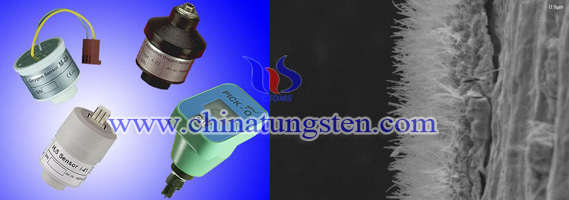Tungsten Trioxide Nanowire Gas Sensor
Tungsten trioxide is one transition metal oxide among a lot of metal oxide, belonging to the n-type semiconductor with its very widespread application. As a semiconductor gas sensor, tungsten trioxide has been considered one of the most promising new oxide sensitive materials to detect NO x, SOx, NH3, H2S, etc.. Since carbon nanotubes have been discovered in 1991, the more innovative electrical, magnetic, optical, thermal and other physical and chemical properties of one-dimensional nano-materials rendered have caused more and more attention, and showing its value and broad application prospects. While, compared to the traditional tungsten oxide material, tungsten trioxide nanowire because of its greater surface area has broad application prospects on the fields of gas sensors, electroluminescence, photoluminescence, conductivity electrode and photocatalysis. In addition, the tungsten oxide nanowires also have a higher surface activity and stronger adsorption capacity, thus to speed up the reaction with gas, and finally greatly improve the sensitivity and further reduce the operating temperature of the gas sensor.

Preparation steps of tungsten trioxide nanowire gas sensor are as follows:
1. Sodium tungstate as raw material to prepare tungsten trioxide nanowire by hydrothermal method;
2. Tungsten oxide nanowire as the main material, coordinating with adhesive-ethyl cellulose and terpineol, and add the appropriate amount of glass material to enhance the adhesion between the alumina substrate and the sensitive material, mixing and stirring uniformly of the above materials at appropriate proportion to obtain a gas-sensitive material slurry;
3. Gas sensor sintering process: print the above slurry on the alumina substrate which is covered with silver electrode and lead, then placed at 80°C for sufficiently drying in the air, and then transferred to a box furnace at 300~450°C for sintering for 1 to 2 hours to obtain the tungsten trioxide nanowire gas sensor element;
4. Component aging process: the gas sensor is aged at 300°C for 120 hours to the final tungsten oxide nanowire gas sensor.
Experiments showed that this tungsten oxide nanowires gas sensor has a high sensitivity, excellent repeatability and good stability for low concentrations (l~100ppm) hydrogen, CO and ammonia.
If you have any other question or inquiry of tungsten oxide, please feel free to contact us through the following methods:
Tel.: +86 592 5129696/86 592 5129595
Fax: +86 592 5129797



评论
发表评论